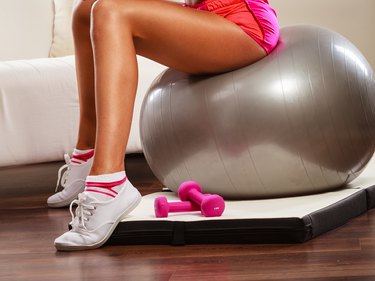
No matter your fitness level, an exercise ball, also called a stability ball, fitness ball or Swiss ball, can add an element of fun to your workouts. When used correctly, the ball enables you to perform a number of exercises to help improve your balance, muscular and core strength, and flexibility. The 65 cm exercise ball is one of the larger sizes available. If you've never trained with this size, getting started is not difficult. Simply follow the manufacturer's set-up instructions and guidelines.
Pump It Up
Video of the Day
Exercise balls are inflated to size, not air pressure. A 65 cm ball, when fully inflated, is 25 inches tall. To ensure your ball measures this height after pumping it up, make a reference mark on the wall, 25 inches from the floor. The balls come with an installed plug and an adapter that attaches to most bike pumps. Allow the ball to warm up to room temperature before inflating. Remove the plug, start pumping, stop when it is 4 inches less than its maximum height -- 21 inches -- and then insert the plug. After 24 hours, complete the inflation process. As you pump, check it against your reference mark, stop when it has reached a height of 25 inches and insert the plug.
Video of the Day
Check the Fit
Your height dictates the best size ball for your needs. If you are between 6 feet and 6 feet five inches tall, the 65 cm ball is the right size. To be sure, sit up tall on the ball and put your feet flat on the floor. If your hips and knees are bent 90 degrees, the ball is a good fit for you.
Safety and Precautions
Work with your exercise ball in an area where there is plenty of open space, away from walls, other fitness equipment and furniture. The floor surface should be flat, smooth and free of any small, sharp objects. Keep the ball away from direct heat sources, such as space heaters or fireplaces, and avoid exposing your ball to long periods of extreme sunlight. Before exercising, remove your rings, watch and any sharp objects that could puncture the ball. Practice good form and posture when exercising. Avoid bouncing on the ball when doing exercises that require you to bend or twist your torso because this could cause a back injury.
Caring for the Ball
With proper care and maintenance, exercise balls can perform reliably and last a long time. Clean the ball often with a mild detergent, warm water and a soft cloth. Avoid using harsh abrasive cleansers or chemicals because these could damage the surface of your ball. Inspect the ball often for holes or deep scratches. If your ball has a puncture, instead of patching it, replace the ball. To keep the air inside the ball from expanding or contracting, store it in a safe area where it's not too hot or cold.
Exercise Dos and Don'ts
Perform a short, light aerobic warm-up and check the ball for any damage before starting your exercise session. Maintain proper posture and spine alignment to minimize your risk of back injuries. The exercises are most effective if you keep your core muscles tight throughout and move in a slow, controlled manner through a full range of motion. Rest 60 seconds between each set and 90 seconds between the different exercises. If you have problems with your balance, position the ball against a wall. Avoid muscle imbalances by performing exercises that work the front and back of your body.